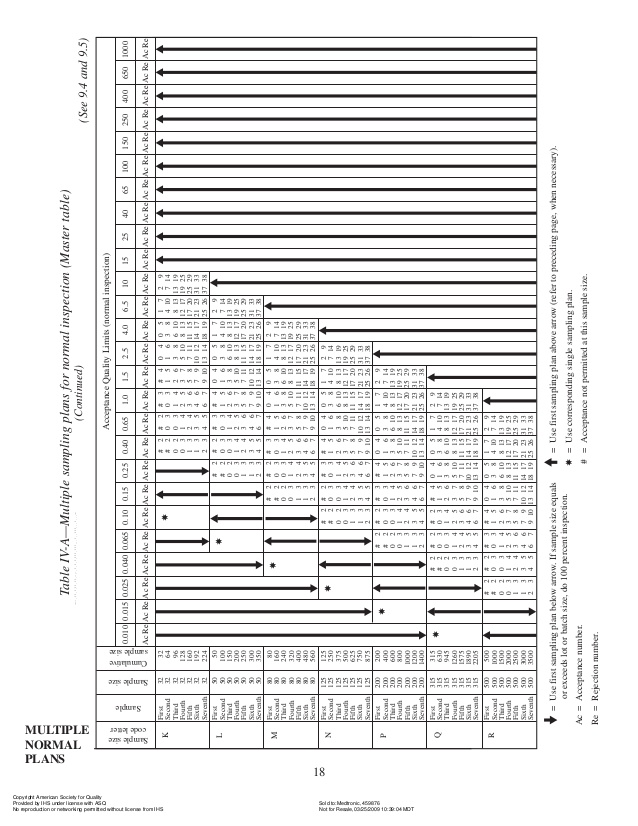

This easy to use slide Rule simplifies and streamlines the process of looking up Accept and Reject numbers for inspection using the MIL-STD-105E, ANSI/ASQ Z1.4-2003 (R2018) or ISO 2859-1 (1999) standard. In this case, the inspection might take one day of work (for S-1, S-2, S-3, S-4, or reduced level), two days (under level II), or three days (under level III).For over 3 decades Quality Inspector's have to been using the AQL Inspector's Rule to ease their job. Again, you can see the differences in sample sizes. Now let’s say you have ordered 40,000pcs of a product. But a trained inspector might be able to do it in one day, whatever the inspection level you choose. General inspection levelsĪs you can see, the numbers of samples to check vary from 5pcs to 315pcs. In the table below, you can see how many samples would be drawn under each of the 7 inspection levels. Let’s say you have ordered 5,000 pcs of a product. Two examples to get a clearer understanding Another situation where special levels are appropriate is container-loading supervision–to have an idea of what is inside the cartons, without spending too much time at that checking. The special levels are used only for certain tests that either take lots of time or destroy the samples. In practice: for consumer goods, quality control is usually performed under the general levels. Under S-3 level, the number of samples to check is lower than under S-4, and so on. “Four additional special levels, S-1, S-2, S-3 and S-4 may be used where relatively small sample sizes are necessary and larger sampling risks can be tolerated” (ISO 2859-1 standard). These special levels can be applied in cases where only very few samples can be checked.
ANSI ASQ Z1 9 2008 PDF HOW TO
Watch this video and learn how to improve management of quality from Chinese & Asian suppliers It can also be interesting for small quantities, where the inspection would take only one day whatever level is chosen. Some buyers opt for level-III inspections for high-value products. More samples are inspected, and a batch of products will (most probably) be rejected if it is below the quality criteria defined by the buyer. If a supplier recently had quality problems, this level is appropriate. It is the most widely used inspection level, to be used by default. The likelihood of finding quality problems is lower than generally recommended. However, settling on this level by default, in order to spend less time/money on inspections, is very risky. Has this supplier passed most previous inspections? Do you feel confident in their products quality? Instead of doing no quality control, buyers can check fewer samples by opting for a level-I inspection. It is usually the buyer’s responsibility to choose the inspection level– more samples to check means more chances to reject bad products when they are bad, but it also means more days (and dollars) spent in an inspection. By the way, that standard has formally been replaced by various commercial standards (ISO 2859-1, ANSI/ASQ Z1.4, and so forth). On the other hand, if an inspection requires tests that end up in product destruction, shouldn’t the sample size be drastically reduced? And if the quality issues are always present on all the products of a given batch (for reasons inherent to processes at work), why not check only a few samples?įor these reasons, different levels are proposed by MIL-STD 105 E (the widely used standard for quality control in the form of acceptance sampling). There is a fairly obvious principle in statistical quality control: the greater the order quantity, the higher the number of samples to check.īut should the number of samples ONLY depend on the order quantity? What if this factory had many quality problems recently, and you suspect there are many defects? In this case, you might want more products to be checked. The question becomes: How many products to check? Actually, a 100% check does not yield that much more information than inspecting a statistically representative sample. Inspecting a large number of products takes a long time: it is expensive, and inspectors are less effective as they get tired. When controlling the quality of a batch of products, it is not practical to inspect 100% of them (unless the quantity is very small).

The need for sampling, rather than 100% checking But it is sometimes necessary to increase–or reduce–the number of samples to check. Inspection level II (under “normal severity”) is appropriate for most random quality inspections. This article introduces the different options available to buyers when it comes to the representation of product inspection findings.



 0 kommentar(er)
0 kommentar(er)
